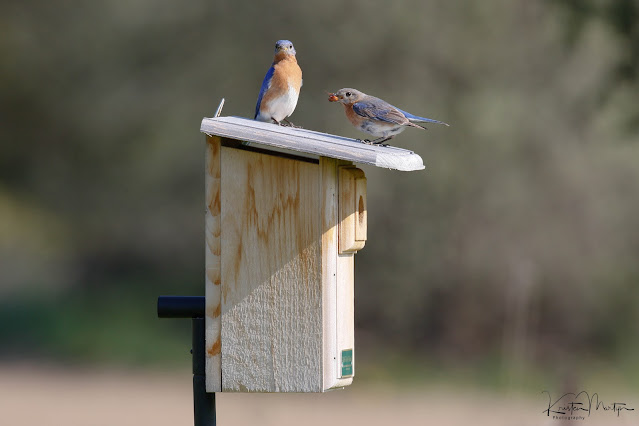As Henry David Thoreau once said “The Bluebird carries the sky on its back”.
Eastern Bluebirds, affectionately referred to as simply bluebirds, are one of the most widely recognized birds on our continent. We see them depicted in art, on mugs, stationary and more (guilty of having a mug).
 |
| Eastern Bluebird. Photo by Heather Kerrison. |
Bluebirds are not difficult to ID, they are in fact blue birds. They display a stunning royal blue colour, with a copper breast patch and white underbelly. Females are more drab and grayish with the copper patch. They favour open fields and woods and are most often observed sitting on fence posts and telephone wires, singing their warbling song.
Bluebirds are mainly insectivorous, but differ from other insectivorous birds. Unlike aerial insectivorous species that grab insects out of the air, bluebirds specialize in eating insects that live on the ground. They eat a wide range of caterpillars, beetles, grasshoppers and more.
To the surprise of many, some Bluebirds overwinter in Ontario. They are able to live in cold weather, but do have to make adjustments to their diet. As the weather shifts and insect availability declines they will consume largely fruits to survive including staghorn sumac, juniper, and wild grapes. This re-highlights how important planting some of these native species can be for attracting and supporting local biodiversity.
 |
| Here the female Bluebird has a June bug on a WBU Eastern Bluebird House. Photo by Kristen Martyn. |
Attracting Eastern Bluebirds to Your Yard
Although Bluebirds are not seed eaters, there are multiple ways to attract them to your yard.
- Offer a water source: bird baths as a water source are a valuable resource for all birds, and a great way to attract birds that aren't seed eaters. All birds need water, and you may be surprised by who visits, including bluebirds.
- Foods: although they are not typical seed eaters, they will visit for a wide range of offerings, including: Bark Butter, Bark Butter Bits, mealworms, and sunflower chips. Live mealworms are by far their favourite, as they closely resemble the bugs they naturally consume. Try putting a little tray of mealworms on your feeder setup and see what happens.
- Feeders: Bluebirds prefer more open style feeders, as they make it extra easy for them to grab a bite and keep going. The Glass Mealworm Feeder is a great way to incorporate some mealworms into your feeder display. WBU APS Feeder Brand Perches Arms are also another convenient option, as you can fill the cups with speciality offerings such as mealworms and BirdBerry Jelly.
- Nesting Boxes: if you live near good bluebird habitat, it's likely that you would be successful in attracting a nesting pair with a nesting box. The WBU Eastern Bluebird House is one of the finest bluebird houses on the market! It has a predator guard to keep out starlings, squirrels and other undesirables. The small floor also serves to discourage sparrow nests. This deluxe suite features ventilation and drainage holes, doors that open for easy cleaning, hooks for hanging, and a textured exterior so that fledglings can easily leave when they are ready. It’s even approved by the North American Bluebird Society.

















No comments:
Post a Comment